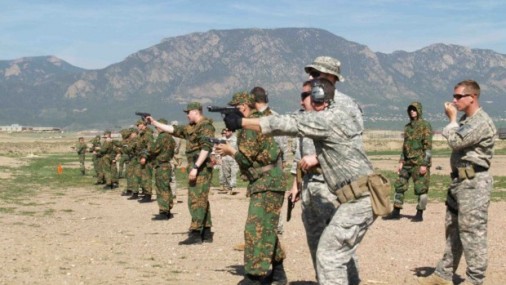
In 1989 the Berlin Wall came down along with much of our common sense on our relationship with Russia. A relatively recent rush of military-to-military training exercises with the Russians has likely helped Russia become more effective and likely even facilitated the invasion of Crimea.
When the Soviet Union died the Soviet military fell into a shambles. What has risen like a Phoenix since then is a massive rebuild of the Russian military. Some recent Russian Army developments include a transition from a largely conscript force to a volunteer one. Russia has introduced NCO training academies strikingly similar to US Army schools. Like the US Army Russia has de-emphasized division sized units and operations in favor of smaller, more deployable brigade operations and created their own version of Special Operations Command as an overarching command organization for their special operations forces.
One of the Russian NCO academies is at the Ryazan higher airborne (VDV) school. It is under the jurisdiction of the Russian Airborne forces that coincidentally spearheaded the Russian invasion of Crimea.
Russian Defense Minister Anatoly Serdyukov, in 2008 instituted reforms de-emphasizing division size operations to smaller more flexible brigade sized forces. The most capable units of conducting independent operations free from external support elements were to be newly organized motorized rifle brigades equipped with BTR-80 vehicles, all of which is strikingly similar to US Stryker Brigade organization and employment. Coincidentally, the eight wheeled armored vehicles pictured in the extensive coverage of Russian troops in Crimea are BTR-80’s.
Recently, the Russians stood up their version of SOCOM. USSOCOM was created to avoid future failures like Operation Eagle Claw, the failed attempt to rescue the Iranian embassy hostages. Centralizing special operations into a command under a four star general protects and separates the special operations training and equipping pipelines. It also provides a separate chain of command to ensure special operations forces are employed more effectively and incorporated into future operations.
Most importantly, the US went from near zero military-to-military joint exercises with Russia from the Cold War up to 2008 to 50 in 2011 and 70 in 2012. Exercise “Atlas Vision” 2012 and 2013 stand out. Using state of the art US simulations, Russian commanders conducted command post exercises with US forces focused on peacekeeping scenarios. A US military participant with decades of experience was struck with the planning strictness of Russian command and control processes during “Atlas Vision” 2012. He observed in “Atlas Vision” 2013 the same Russian staff officers were involved and requested the exercise include “deeper—joint command and control processes tailored to the US processes/procedures and using our standard reporting formats but tailored to the Russian standard command and control.” They also requested deeper logistics and command and control play. We obliged.
The US observer, as one of the only participants with Cold War service asked, “WHY are they so interested in our C&C (command and control) processes?” He was reminded the Cold War was over. After this well conducted exercise was completed, the US participant acknowledged the Russians rapidly understood and employed our peacekeeping doctrine implementing a US style command and control which included strict Rules of Engagement procedures previously unknown to Russian planning processes.
One can gain an understanding of how US units plan, resource, execute and supervise operations from a manual, many of which are available online or can be procured through other means. Conducting those operations in complex simulations with experienced US personnel is priceless in understanding the relationships, roles and decision making that characterizes US warfighting doctrine. It’s the difference between reading how to do a force out double play and participating in practice with a major league baseball team.
Fast forward to today and contrast Russia’s performance in Georgia with the well run occupation of Crimea. Crimea’s occupation has exemplified without bloodshed a supremely efficient takeover of every strategic government office, military base and transportation facility. A coincidence? Maybe, but there’s an awful lot of them.
